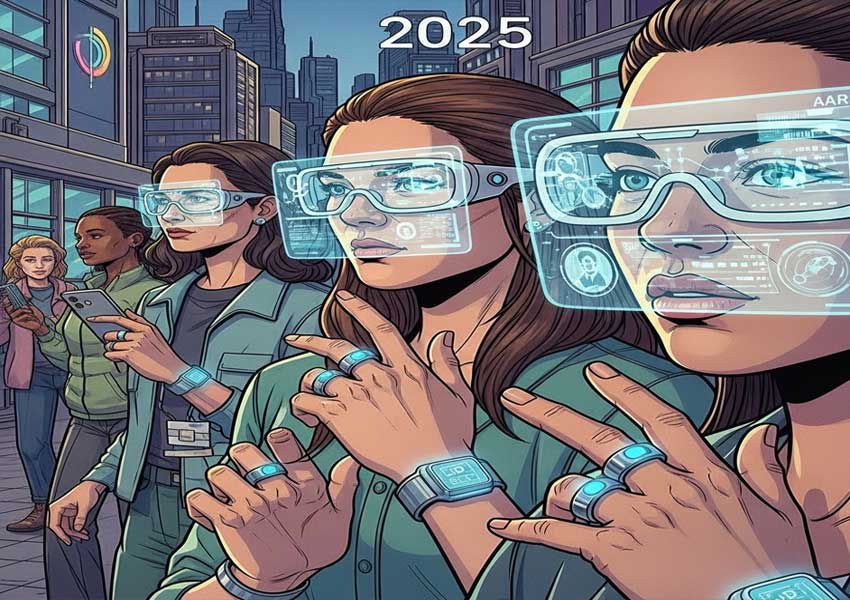Blogtubers – Wearable Tech 2025 is redefining how we interact with technology—literally on our fingertips, wrists, and even through our eyes. As innovation in wearable devices accelerates, smart accessories are becoming less about novelty and more about necessity. Whether for health, productivity, fashion, or entertainment, wearables are now integrated into daily life like never before.
With major brands competing to lead the next wave of personal tech, 2025 marks a turning point. From smart rings tracking blood oxygen levels to AR glasses displaying directions mid-walk, wearable tech is transitioning from futuristic concept to present-day practicality.

The Evolution of Wearable Tech 2025: From Trackers to Smart Ecosystems
Five years ago, wearables were mostly limited to fitness trackers and smartwatches. But by 2025, the ecosystem has expanded into multiple categories:
- Smart rings
- AR (Augmented Reality) glasses
- Smart clothing
- AI-powered earbuds
- Health-monitoring patches
These devices are not only more compact and stylish but also smarter, thanks to improved AI integration and advanced biometric sensors.
According to Blogtubers, global interest in wearables rose by 47% in early 2025 compared to the same period in 2024, with Asia leading the surge—particularly in health-focused devices and AR applications.
Smart Rings: The Tiny Titans of Health Tech
Smart rings have become one of the biggest success stories of Wearable Tech 2025. These unobtrusive devices offer powerful tracking capabilities, including:
- Heart rate variability
- Blood oxygen levels (SpO2)
- Sleep cycles and REM analysis
- Stress and temperature monitoring
Leading brands like Oura, RingConn, and Ultrahuman are setting new standards. Their smart rings now sync with mobile health apps and can give real-time alerts for irregular heartbeat or poor recovery data—critical for both athletes and everyday users.
Blogtubers notes that smart rings are gaining popularity among professionals and minimalists who prefer lightweight, discreet tech over bulky wearables.
Read more: “Main Character Energy: TikTok Trend Helping Mental Health“
AR Glasses: Blending the Real and the Virtual
No longer just a Silicon Valley dream, AR glasses are a central feature of Wearable Tech 2025. Companies like Apple, Meta, and Xiaomi have launched stylish glasses that:
- Display messages and navigation
- Translate signs in real-time
- Sync with smart home systems
- Overlay AR visuals on physical environments
Meta’s “QuestView Lite” and Apple’s “VisionSpecs” are leading the category. With sleek frames and HD displays, these devices are becoming daily tools for tech-savvy commuters, creatives, and remote workers.
In a review published by Blogtubers, AR glasses were described as “the smartphone’s next evolutionary step—hands-free and instantly connected to your world.”
Earbuds and Hearables: Your Personal AI Assistant
Earbuds have transformed into intelligent hearables—devices that not only deliver sound but also respond to commands, filter environmental noise, and monitor your health.
Popular 2025 features include:
- Real-time language translation
- Personalized sound zones
- Heart rate and posture feedback
- Voice-activated task scheduling
Samsung’s “Galaxy Buds AI” and Sony’s “SensePods” are examples of how earbuds are blending entertainment with productivity.
Smart Clothing and Skin Patches: The Next Frontier
While still emerging, smart fabrics and biosensor patches are gaining traction in sports and medical fields. Imagine a running shirt that tracks your hydration, or a skin patch that reports blood sugar data directly to your phone.
Universities and startups are driving innovation here, creating wearables that feel like regular clothes but deliver clinical-grade data.
By the end of 2025, several Southeast Asian brands are expected to release mass-market smart garments, tailored for tropical climates and daily wear.
Wearable Tech 2025 and Health: A New Era of Prevention
One of the most impactful applications of Wearable Tech 2025 is in preventive healthcare. Devices are now capable of detecting subtle changes in body function—often before symptoms appear.
Use cases include:
- Early detection of respiratory illnesses
- Monitoring recovery post-surgery or illness
- Real-time alerts during physical activity
- Mental wellness tracking via stress and mood scores
Doctors and hospitals in Indonesia and Malaysia are starting to integrate patient wearable data into their healthcare systems. This “always-on” health monitoring could lead to faster diagnosis and lower treatment costs.
Power and Privacy: The Two Big Challenges
Despite the excitement, challenges remain. Battery life continues to be a limiting factor, especially for power-hungry devices like AR glasses. Efforts to improve fast charging and wireless energy transfer are in development.
Privacy is another major concern. With wearables constantly collecting sensitive data, the need for transparent policies and robust data protection is urgent.
Governments across Asia are now drafting new laws to regulate biometric data collection from wearable tech, especially in public settings.
Integration with Smart Ecosystems
Wearable tech doesn’t live in isolation. Devices in 2025 are part of broader smart ecosystems:
- A smart ring can unlock your door and log your sleep data.
- AR glasses sync with your smart fridge or virtual assistant.
- Hearables let you dictate emails, control your TV, and manage your calendar—all hands-free.
This seamless integration is turning daily routines into efficient, intuitive workflows. It’s no longer about owning the most gadgets—it’s about how well they communicate with each other.
What to Expect in the Future of Wearable Tech
Looking ahead to 2026 and beyond, trends point toward:
- More invisible tech: Implants, tattoos, or nano-sensors.
- Longer battery life: Through solar or kinetic energy.
- Emotion-aware AI: Devices that sense mood and adapt interactions.
- Hyper-personalization: Tailored wellness plans generated by wearables and AI together.
As Wearable Tech 2025 matures, it’s clear that the line between human and machine interaction is growing thinner—and more helpful.
Wearable Tech 2025 is more than a trend—it’s a lifestyle shift. These devices empower users to live healthier, work smarter, and stay connected in seamless, unobtrusive ways. From smart rings that analyze sleep to AR glasses that navigate the real world, wearable tech is shaping how we experience life—both online and offline.
According to Blogtubers, 2025 is the year wearables stopped being optional gadgets and became essential digital companions. Whether you’re a techie, athlete, student, or remote worker, there’s likely a piece of wearable tech designed to upgrade your life.



